Back in 2001, riots broke out in northern cities in England sparked by ethnic tensions. The Cantle Report on the riots in Bradford, Oldham and Burnley claimed that ethnic communities there lived parallel and polarised lives: “These lives often do not seem to touch at any point, let alone overlap and promote any meaningful interchanges.” Ethnic segregation existed in schools, largely as a consequence of residential segregation or the admissions policy operated by some schools. This pattern was further exacerbated by government support at the time for single-faith schools.
Writing a few years later, Guardian columnist Polly Toynbee described the growth of faith schools as: “among the most indelibly damaging of Tony Blair’s social legacies, his permanent bequest to his own beliefs”. Blair’s support for faith schools was largely based on the claim that they achieved higher performance outcomes for their pupils, but many worried that this opened the door to fundamentalist Christian influence.
Schools in the spotlight
Following the Trojan Horse scandal in Birmingham schools in 2014, Ofsted, the school inspectorate, expressed concern that some private Muslim schools were failing to promote British values and protect their pupils.
In February, a school principal was forced to deny that three girls who left Britain to go to Syria were radicalised at school. In 2012, an Ofsted report on their school, the Bethnal Green Academy – which is not a faith school – found it to be outstanding on all measures, but noted that three quarters of its students did not have English as their first language and that the proportion of students from minority ethnic backgrounds was much higher than the national average.

Cost of segregation
Is it any wonder that many feel that faith schools should be banned altogether? This was the reaction from some groups at the publication of the latest report from the Social Integration Commission. It is the third report in a series that has examined the changing face of British society, looking particularly at the level of integration or segregation of people on the basis of age, ethnicity or social background. Previous reports highlighted that Britain is becoming an increasingly diverse society, but the level of engagement between members of different communities is not keeping pace. They have pointed to powerful evidence that segregation entails negative consequences and additional financial cost.
The section of the latest report on schools rings familiar alarm bells: the highest level of integration is found amongst the 18-35 age group, who are either more mobile, or in further or higher education. By contrast, levels of ethnic segregation are high among school-age children. Social and religious segregation is rising, aided in part by the current government’s commitment to free schools – state-funded schools that are outside of local authority control.
England is not alone in trying to find solutions to these problems – and there is no blueprint solution. While the 2001 riots in English cities were taken by some as a failure of a multicultural commitment to celebrate diverse identities, riots in the suburbs of Paris in 2005 were cited as evidence of the failure of the French commitment to social integration through the unitary and secular tradition of civic republicanism.
Public funding can be held to account
But banning faith schools is unlikely to be successful at reducing social segregation. Under current education law it would not be possible for a government to ban faith schools entirely. The right to establish and direct separate schools is contained in the Convention of the Rights of the Child, and the application of this in English law makes it permissible to establish independent schools, subject only to them meeting some basic educational standards. Faith schools could, however, be denied access to public funding, but this may have unexpected and undesirable outcomes.
If the concern with faith schools is that they become narrowly insular, then pushing them into the private sector only makes that outcome more likely. As long as faith schools receive public funding then they can be held to account for their admissions policy, curriculum and wider practice.
In all these respects the recommendations of the Social Integration Commission seem to be spot-on. It recommends that faith schools should be encouraged to provide more opportunities for their pupils to interact with children from different ethnic communities and income backgrounds, through partnerships, shared facilities or the co-location of schools.
It also recommends that religious education in faith schools should cover a diversity of faith traditions, and not take the form of religious instruction. The admissions code of practice should encourage each faith school to admit a mix of pupils which reflects local diversity and demography. Nor should they be restricted only to members of the faith community. And the school buildings themselves should become spaces for local community engagement.
A network of schools
We should not be afraid of institutional diversity, as long as the diverse elements are well connected to ensure that all boundaries are porous and all schools are places where generations and communities have opportunities to meet and learn from one another. Faith schools should be embraced as part of a diverse education system, but obliged to engage with as many others as possible.
Despite adopting fundamentally divergent policy approaches, Britain and France risk ending up with silo societies where too many communities live their lives apart. Rather than focus on individual schools, we should think of the school system as a network. In this way, we should be promoting networked solutions in which schools collaborate to connect pupils, teachers, parents and communities to the greatest extent possible. In such a connected world, diversity among the elements of the network will not be a problem and indeed may even be an advantage.

